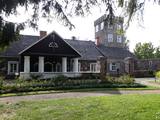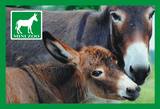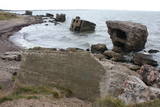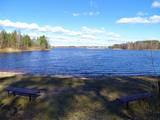| Nr | Name | Beschreibung |
|---|---|---|
|
Im Rittergut Burbiškis wurde 1991 das kulturgeschichtliche Museum Daugyvenė gegründet. Das Schutzgebiet umfasst eine Fläche von 28 ha. Im zentralen Teil des Parks befindet sich ein 3 Hektar großer Teich mit 15 Inseln, 11 Brücken und Stegen. Seit 2000 findet hier alljährlich das Tulpenfestival statt, auf dem etwa 300 Tulpensorten ausgestellt werden. |
||
|
Latvia is the land of apples, so producing cider here is only natural! The ancient traditions of apple growing in our country, as well as the variety of high-quality apple cultivars, are key advantages of Latvia's cider culture. In our climate zone, it is challenging to grow good grapes for wine production, but the local conditions are particularly suitable for making apple cider. This is a natural consequence that local cider producers are increasingly mastering with excellence. The Cider Route will take you to various cideries in Latvia, as well as to restaurants and pubs that serve it. The Cider Route allows you to understand the specifics of Latvian cider, introducing you to the culinary traditions and cultural heritage of different regions. You will have the opportunity to meet the cider makers themselves, who run small farms, tend to the orchards, share about their work, and even let you participate in it. |
||
|
Der Tērvete Naturpark befindet sich in einem Gebiet, das nicht besonders typisch für die Zemgale Region ist – im Tērvete - Flusstal. An seinen Ufern gibt es riesige Wälder, die sich gut für Freizeitaktivitäten eignen. Es gibt Naturdenkmäler und auch hervorragende Kultur- und Geschichtsdenkmäler in dieser Gegend. Der Tērvete Landschaftspark ist einer der beliebtesten touristischen Ziele in Zemgale. Die Besucher finden hier einen Wald mit uralten Kiefern, einen herrlichen Landschaftspark, das Sprīdīši-Arboretum, die Burgberge von Tērvete, Klosterkalns and Svētkalns, das Museum “Sprīdīši”, das der großartigen lettischen Autorin Anna Brigadere gewidmet ist, verschiedene Kinderattraktionen, schöne Landschaften, ein enges Netz von Wanderpfaden usw. Dieser Naturpark ist 2004 zum familienfreundlichsten Ort in Lettland ernannt worden.
|
||
|
Die Wirtschaft bietet die Besichtigung von verschiedenen Arten von Ponys u.a. Tieren (Zwergziegen, Ziegen) an. Ein besonderes Angebot für Schüler – Ausflug „Lerne die Ponys kennen”. Die Kinder können auf den Ponys reiten, Forellen füttern, sowie an der Lehrveranstaltung über die Verpflegung der Tiere teilnehmen.
|
||
|
Atrodas Vecpiebalgas dienviddaļā pie Inešu ceļa. No sarkanajiem ķieģeļiem būvētā ēka uzcelta 1887. g. par vietējo iedzīvotāju saziedotajiem līdzekļiem. Vairāk nekā simts gadus šī ir vieta, kur vecpiebaldzēni pulcējas uz nozīmīgiem notikumiem, svētkiem, uzturot novada kultūras mantojumu. Celtni uzskata par vienu no spilgtākajiem Latvijas lauku arhitektūras pieminekļiem. Tai blakus uzstādīts piemineklis brāļiem Kaudzītēm. |
||
|
The tour introduces a variety of attractions and values outside big cities revealing the true character of the countries. Visitors will experience the beauty of nature in national parks, charming ambience of rural manors, visit traditional rural farms and skilful traditional artisans and craftsmen. |
||
|
Ideja par "DA'ZIEPE" radās iedvesmojoties no Amatas novada dabas un idejas par pilnvērtīgu pieejamo resursu izmantošanu. Ziepes tiek gatavotas no liellopu vai briežu taukiem, augu eļļām un ziepju zālēm, kā arī papildinātas ar dažādām ēteriskajām eļļām un dabīgajiem aromātiem. |
||
|
Zemnieku saimniecība "Dzirnas" nodarbojas ar bioloģisko putnkopību, audzē zemenes un dārzeņus. Saimniecība apsaimnieko 11 ha zemes. Tajā iegūtās olas ar zīmolu "Vistu olas", sīpoli un ķiploki tiek pārdoti veikalos "Klēts" Rimi hypermārketos Rīgā. Savukārt zemenes pārdod dzimtajā Alsungā, kā arī pēc pieprasījuma piegādā Rīgā. Iespējams arī apmeklēt un apskatīt saimniecību, taču nepieciešmaa iepriekšēja pieteikšanās. |
||
|
Vecauces ev. lut. baznīca ir valsts nozīmes arhitektūras piemineklis. Baznīca pirmo reizi uzcelta kā koka būve 1667. gadā, bet pēc zibens spēriena 1729. gadā tā nodega. Mūra baznīca celta 1744. gadā, savukārt 1866.gadā Mēdemu valdīšanas laikā baznīcu paplašināja līdz 500 sēdvietām, izgatavoja jaunu altāri, kanceli un uzstādīja Liepājas ērģeļmeistara Kārļa Hermaņa būvētas ērģeles. meklētājiem piedāvā doties interesantā, izklaidējošā un informatīvā ekskursijā pa baznīcu, apskatot ekspozīciju "Auce pirmās Latvijas brīvvalsts laikā" un baznīcas bibliotēku (Baznīcas grāmatas (pirmās Latvijas brīvvalsts laiks – 1918.-40.g., vācu laiks, padomju laiks un šodiena)). Baznīcā izveidotajā Mākslas telpā apskatei tiek piedāvātas vairākas unikālas ekspozīcijas: skolotājas Jadvigas Kupčes grāmatu un personīgo lietu ekspozīcija, kantātes “Dievs Tava zeme deg” vārdu autora Andreja Eglīša ekspozīcija, izcilā flamenko ģitārista Andreja Kārkliņa un režisora Kārļa Pamšes ekspozīcijas. |
||
|
Der Hof befindet sich in schöner, ruhiger Lage, an einem Teich, der mit seinem Fischreichtum jedes Anglerherz erfreut. Als Gästehaus dient der ehemalige, 120 Jahre alte Speicher, in dem sich jetzt die Schlafräume, die Küche und die Sauna befinden. |
||
|
Atrodas Talsu centrā, tirdzniecības centra „Talsu centrs” trešajā stāvā. Moderns, mūsdienīgs interjers. |
||
|
Saimniecības zemi, kas atrodas starp Ulbroku un Vālodzēm, 1929. gadā nopirka tagadējā saimnieka – Dzintara Āboliņa vectēvs. Tajā laikā arī tika uzcelta klēts, kurā glabāja saimniecībā izaudzēto lauksaimniecības produkciju. Krīvu klēts atdzimšana notika pirms 20 gadiem, kad tagadējie saimnieki tajā uzsāka veidot muzeju no sadzīves priekšmetiem un darba instrumentiem, kas savulaik izmantoti Krīvu saimniecībā. |
||
|
“Jumari” atrodas Dundagas pagasta Valpenē - ciemā, kurā bērnību un jaunību aizvadījis Krišjānis Barons. “Jumaros” saimnieko šīs dzimtas ļaudis jau septītajā paaudzē. Saimniecībā audzē augļus, ogas t.sk. krūmmellenes un dārzeņus. Skaistumu dāvā puķes un košumkrūmi. Ciemiņi var apskatīt saimniecību, iepazīties ar krūmmelleņu audzēšanu un bioloģiskās saimniekošanas metodēm, nobaudīt zāļu tējas. Saimniece gatavo zāļu spilventiņus, austas grāmatzīmes, cep sklandraušus. “Jumari” ir iekļauti kā viens no apskates objektiem Dundagas novada velomaršrutā “Barona bõgans”. |
||
|
Anglā interesentus gaida Sāmsalas vienīgais savu sākotnējo izskatu saglabājušais Vējdzirnavu paugurs ar piecām vējdzirnavām, no kurām četras, tā saucamās “bucenes”, ir tipiskas šīs salas pārstāves, bet vienas - holandiešu tipa vējdzirnavas. Visas dzirnavas ir atvērtas apmeklētājiem. Kultūras mantojuma centrā var apgūt igauņu tradicionālo darbu prasmes, piedalīties tautas kultūras pasākumos un nogaršot Anglas rudzu maizi. |
||
|
Viena no skaistākajām Dienvidlatgales koka baznīcām. No baļķiem celtais un ar dēļiem apšūtais dievnams tapis laikā no 1750. - 1751. g. Baznīcā saglabājies 18. gs. veidotais altāris (baroka kokgriezumi) un ērģeļu prospekts, kā arī tās iekārtā ietilpst vairāk nekā 30 mākslinieciski nozīmīgi priekšmeti. Baznīcas pagalmā slejas 19. gs. celtais zvanu tornis. Nedaudz tālāk – Rušona ezera virzienā slejas no koka celtā mācītājmāja. |
||
|
Daiļamata meistars no koka taisa karotes (no liepas, bērza koka) un pirtsslotas (ar āboliem). Darba vērošana, iespēja pašiem izgatavot karoti, gatavās produkcijas iegāde un karošu kolekcijas apskate. Aplūkot vērtas ir vecās saimniecības ēkas. |
||
|
Netālu no Rīgas apvedceļa Daugavas labajā krastā atrodas 1994. g. atklātais un tēlnieka Ģ. Burvja veidotais piemineklis - piemiņas zīme. Veltīts Daugavas lībiešiem un viņu Mārtiņsalas vadonim – lībietim Ako, kas 1206. gadā vadīja cīņu pret krustnešiem. Pieminekļa apkaimē gar Daugavas krastu izveidota plaša atpūtas un pastaigu vieta. Šī ir viena no ainaviskākajām vietām Daugavas lejteces krastos. Mazliet tālāk upes krastā izvietoti informatīvi stendi, kas atspoguļo Daugavas krastu vēsturi pirms Rīgas HES izbūves. |
||
|
Viena no Latvijas vizuāli izteiktākajām krasta aizsardzības baterejām. Kādēļ? Tās pozīcijas un atsevišķie elementi ir vai nu pilnībā vai daļēji ieskaloti jūrā, radot Latvijas jūras krastam neparastas ainavas. Sevišķi iespaidīgas tās ir vētru laikā. Diemžēl, bet šis vēstures piemineklis ir pakļauts dabas spēku varenajām norisēm. Batereja redzama arī no Liepājas Ziemeļu mola. Vērts doties nelielā pārgājienā gar jūru uz 4 km attālajiem Ziemeļu fortiem, kur pa ceļam ir apskatāma arī 23. Krasta aizsardzības baterejas pozīcijas.
|
||
|
Atrodas Talsu dienviddaļā, netālu no pilsētas apvedceļa – aptuveni kilometra attālumā no Talsu centra. Uzņēmums ar ilgām ēdināšanas tradīcijām. Klāj galdus svinīgiem pasākumiem un piedāvā plašu ēdienu klāstu no sātīgām maltītē līdz dažādiem konditorejas našķiem. |
||
|
Pēc Rīgas HES ūdenskrātuves izveides – sala, pirms tam – Daugavas kreisā krasta pussala. 1. pasaules kara laikā Nāves salā norisinājās ilgstošas latviešu strēlnieku kaujas pret vācu armijas pārspēku. 1916. g. 25. septembrī vācieši pret latviešu strēlniekiem izmantoja indīgas kaujas gāzes. Lai godinātu šos notikumus, 1924. g. pēc arhitekta E. Laubes projekta Nāves salas ziemeļu krastā uzbūvēja pieminekli kritušajiem latviešu strēlniekiem. Nāves sala sasniedzama ar laivu. Ir vērts iepazīst salā esošos ierakumus un kapuvietas. Nāves salas ZR krastā ir izbūvēta laivu piestātne, bet netālu no tās - atpūtas vieta. Cīņas Nāves salā aprakstījis Aleksandrs Grīns savā leģendārajā darbā „Dvēseļu putenis”. |
||

























